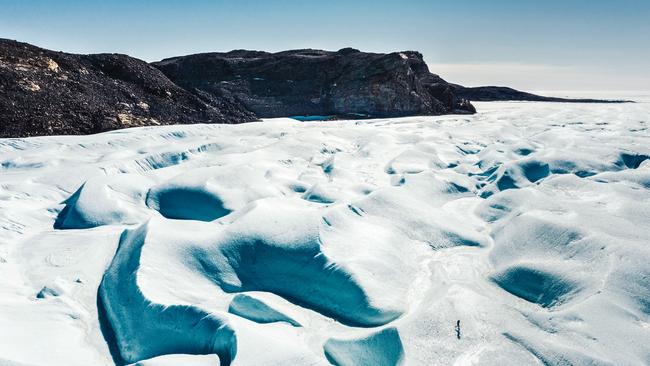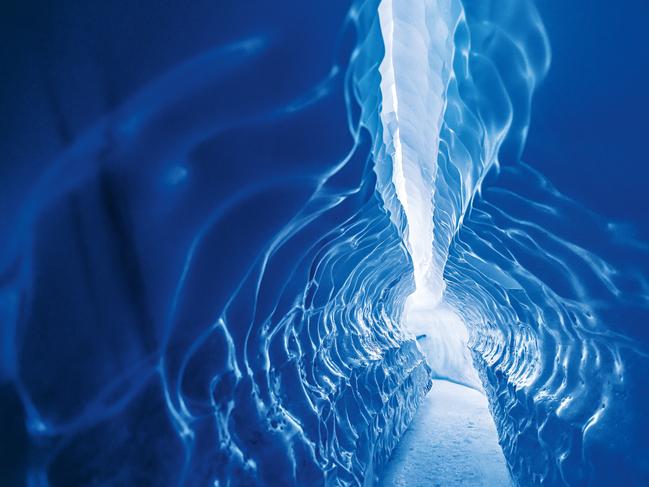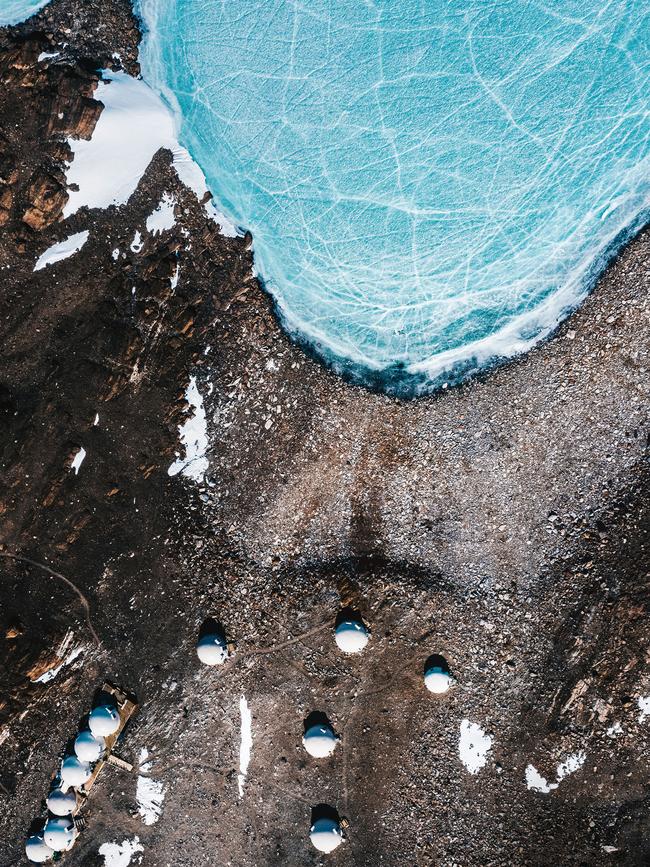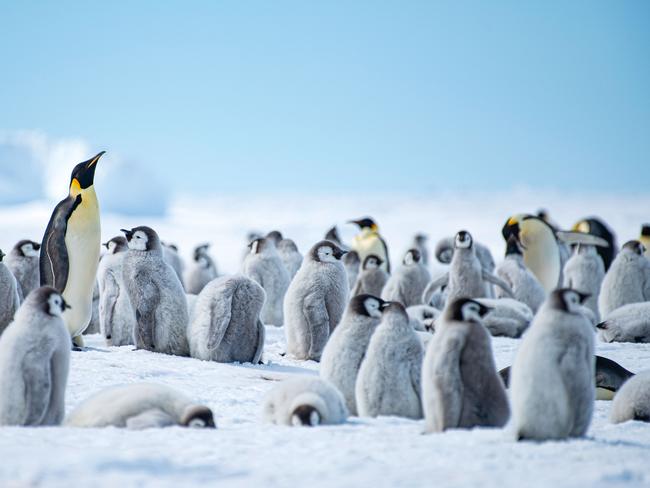The destination you should have on your bucket list: the end of the earth
Antarctica captures the imagination of modern-day adventurers as much as the ‘white south’ obsessed the early explorers.

Apparently, it’s a common feeling, this lingering obsession. Looking back now on my time at the end of the world, I’m haunted by Antarctica. It feels unreal, dreamlike – those ice lakes scattered with star points of light, the immense snow cliffs with their blue shadows, the gossamer sheen of silver across the ridges of frozen ocean, the abstract white shapes. Nothing prepares you for this place. It’s a continent of superlatives – the coldest, driest, highest, windiest space on the planet. But its beauty is what will break your heart.
I had flown south from Cape Town, five and a half hours across the Southern Ocean. There was cloud cover for much of the way, but after three hours the sky cleared and I looked down on icebergs afloat on a sea of intense blue. From 35,000 feet, I suddenly realised they were the size of large cities.
The Gulfstream landed on a frozen runway. Having kitted up inside – at minus nine Celsius, it was a modest four-layer day – I stepped out into that dry, rasping air, into light so tangible and wonderful I felt I could gather it up in my hands. Aside from some tents and Nissen huts, it was a vast, empty world. To the right the sculptural sweep of snow and ice was interrupted by sharp-toothed mountains like black cut-outs against a turquoise sky. They gave this runway its name: Wolf’s Fang.
I was told they were high mountains, but in this fathomless expanse, their scale was impossible to judge. Were they huge peaks or mere ridges that one could scamper up in an hour? In Antarctica there are no points of reference.
No one owns this continent. There is no passport control, no immigration regulations, no border post. In a gracious fashion, countries recognise one another’s territorial claims – there are seven in all – even though they often overlap and have no legal status. Antarctica is the only place on earth where you are not within any political entity – where you are officially nowhere.
Its history is tenuous. For millennia, Antarctica was undiscovered, though people seemed to sense its presence; ancient Greek scholars spoke of a mysterious southern continent. Some believed it would be a fair land of happy people and fertile fields – an idea definitively disproved when it was first sighted, from the crow’s nest of a flagship, in January 1820.

By the early 20th century, Antarctica had become the province of explorers and madmen, the sorts of fellows who were drawn to the remotest corners of the British Empire, heartbroken at having missed out on dengue fever in the sodden jungles of Borneo or spear wounds in the Zulu Kingdom. Ernest Shackleton, possibly the most prominent of Antarctic explorers, called it the last great journey left to man. And, of course, for some it would be the last they would take. When Apsley Cherry-Garrard, one of the survivors of Robert Falcon Scott’s ill-fated Terra Nova expedition, published his memoir in 1922, the title came easily: The Worst Journey in the World.
But Antarctica is never just a journey. Shackleton admitted that for him and his ilk the continent had become a metaphor. “We all have our own White South,” he said. Antarctica would obsess all these adventurers for the rest of their lives. It was where they had felt most vividly alive. Years later, sitting in the window of his library, reading his old notebooks as an English afternoon faded across his lawn, Cherry-Garrard wrote a note in one of the margins: “Can we ever forget those days?”
In the tradition of these explorers, I should have been hunkered down inside several sleeping bags, a polar blizzard battering the tent, while the dogs howled outside and the contents of my hot-water bottle turned to ice. But Antarctic tour operator White Desert has taken the hardship out of discovery. Its base, Whichaway Camp, in the remote spaces of Queen Maud Land in the east, must count as one of the most exclusive stays in the world. The logistics that support this 12-guest refuge would test a space mission. It consists of seven insulated circular pods on a rare swathe of exposed rock, tethered to the ground in case of sudden storms. Three of the domes provide a spacious communal area with fur throws and a library. Cherry-Garrard would have snorted with disgust at such indulgence.
Crucially, White Desert has put as much thought into environmental impact at Whichaway as it has into comfort. Antarctica is home to 90 per cent of the world’s ice, yet temperatures are rising faster here than almost anywhere else – about three degrees Celcius since the 1950s. Should these trends continue, the effect on global sea levels will be catastrophic. White Desert offsets its flights and activities with accredited carbon-neutral schemes. It has its own solar-powered system for heat and water, and plans to eliminate single-use plastics from its supply chain. All waste is shipped out to be recycled or responsibly disposed of in South Africa. When the camp has reached the natural end of its life span, it will be removed without a trace.
The conventional way to reach Antarctica is on a polar cruise, going ashore via Zodiac boats on excursions to see penguins, seals, and other sea life. More than 50,000 people a year visit this way. But only about 160 stay at Whichaway each season. In groups of five, my fellow guests and I took trips on foot, in the camp’s six-by-six truck, and in White Desert’s Basler BT-67 propeller planes. It felt like a rare privilege.

Of course, it has a price tag to match: a week with White Desert will run you as much as a luxury automobile. I visited during the southern hemisphere summer so it was never dark. Antarctica’s 24-hour daylight was luminous, a neutral canvas the sun painted as it moved around the sky: the pale milky blue of dawn; the rose tint of morning; the crisp white of midday; an afternoon blush like yellowed grass; an evening of pearly, smoky greys; and, at last, the heather-coloured night.
Whichaway sits on the edge of an ice lake with a surface rippled into patterns, as if by frozen winds. One morning we set out across it, our crampons crunching. The lake, the cliffs, and the frosted fields beyond were a study in minimalist simplicity, a paradise of clean lines – austere, vast, unfussy. But there was complexity in the details, too: the web of cracks and veins in the ice; the cryoconite holes, with their exquisite lacework of crystals and air bubbles, created by dust or rock pieces trapped within. On the far side, a section of the cliff broke away and fell with a sound like thunder, shattering the silence. We climbed over a steep shoulder of snow to a sloping expanse rising to the skyline. Roped together, we felt tiny against the magnitude of this place. On the ridgeline we left our crampons in the lee of some rocks and clambered up a nunatak, a stony peak protruding from the glacier. From the summit we looked out into the bright, silent stillness. Stretches of snow and ice tipped away into the horizon without being interrupted by a single alien feature, aside from our own footprints.
This must be what infinity looks like, I thought. No one lives on Antarctica. Even the hardy souls who spend winters in research stations are really only visitors. But it’s not just human inhabitants who are missing. No trees or shrubs grow here; flora is limited to lichen, moss, and algae. The largest land animal is the wingless midge, which grows to just half an inch. The chief birds are snow petrels and skuas. The snow petrels – white calligraphic figures on the blue skies – feed mainly on fish, while the large, gull-like skuas feed on the chicks of petrels and other birds; their nests are surrounded by graveyards of bleached bones. Skuas lay two eggs so that, in this land of sparse resources, they can feed one chick to the other.
In startling contrast to the land, the surrounding seas teem with life, supported by shrimplike krill, the basis of the marine food chain here, which has, at an estimated 500 million tonnes, the largest biomass of any animal species on the planet. Numerous whales come to the Southern Ocean to feed, including blue whales, the earth’s largest creature. There are also southern elephant seals, Antarctic fur seals, and leopard seals. Finally, and most famously, there are the penguins, who feed at sea but breed on land or ice. Everyone seems to have watched the saga of the heroic male emperor penguin nursing a single egg through the gales of winter while the females search for food.
Near the Neumayer III research station, we visited a penguin rookery, safely located a few miles inland from the carnivorous leopard seals. As we approached, a chorus of squawking and squeaking rose from the cold assembly that sounded exactly like a chicken coop. In a society where everyone has turned up in the same tuxedo, voices are important. In a howling midwinter gale, the penguins will be all fearless grit and cold flippers. But at this time of year, the colony felt pleasantly aimless, even idle. The birds were just hanging out, as though at a garden party, making small talk, waiting for the drinks tray to come around again. Occasionally, one would flop down to do some ice surfing, paddling on its belly like a torpedo- shaped toboggan, before slowly getting to its feet again. The youngsters, fluffy, impossibly cute, had the gleeful look of children allowed to stay up past their bedtime.

David Attenborough has called the life of the emperor penguin one of nature’s greatest acts of survival, as well as one of its most romantic love stories. Down on the coast, male elephant seals are tearing out each other’s throats before mating with every female they can lay their flippers on. But male emperors are sensitive, loyal, and eager to share in childcare. They coo affectionately at their wives, who coo back. Then both coo at their single child. From time to time, one parent starts to gag, then leans over and vomits some fish into the little one’s waiting mouth. Even this is managed with decorum.
Another day, we went to the edge of the Southern Ocean. A rumpled apron of frozen sea stretched miles from the shore to the open water – a tumult of colossal rock-solid waves, most taller than a human being. Sunlight cascaded over their shoulders like liquid silver. In the troughs between them lay shadows of watery blue.
Standing there, I felt in awe of this place, of its scale, its splendour, and its beauty. And with that awe, my own life, with all its anxieties and concerns, its minor triumphs and rather less- minor failures, its pain and its hurts, shrank away. It was a wonderful feeling, the amazement and the accompanying loss of self, as profound as meditation.
It was liberating. In that sparkling moment, in the crystal Antarctic air, I thought, there can be no better journey, no better destination, than one that offers this exhilarating feeling of liberation. Even when it means going to the end of the earth to find it.
White Desert’s Antarctica itineraries run from November to February. The Emperors & South Pole trip (eight days; US$92,500 per person) includes full board, transfers from Cape Town.
-
Passage to Antarctica: Sail south on a luxe cruise
Best known for sailing on Europe’s great rivers,Viking is expanding into the polar regions and will launch its inaugural season in Antarctica in 2022-23. The 378-guest Viking Octantis, the first of two expedition ships being built, débuts on January 12, 2022, with the 13-day Antarctic Explorer itinerary from Buenos Aires to the Last Continent via Ushuaia. Submersibles and an onboard lab suggest it will be a truly immersive experience.
Discovery yacht Scenic Eclipse’s Antarctic voyages range from 13-day “in-depth” itineraries to 32-day odysseys that take in the Falkland Islands and Chilean fjords. Either way, guests see the continent in style aboard a ship with verandah staterooms and butlers for all. Two helicopters and a state-of-the-art submersible ensure views above and below the ice.
Silversea has two options for Antarctica. Guests can experience the notorious Drake Passage on one of the line’s opulent expedition ships or fast-track their journey by flying business class from Punta Arenas in Chile to King George Island, boarding their ship there. The Antarctica Bridge program replaces four days at sea with return two-hour flights, and presents an opportunity for itineraries of just five days. Other voyages range up to 29 days.
Australian companyAurora Expeditions will operate 26 expeditions to Antarctica in 2022-23 on purpose-built ships Greg Mortimer and the soon-to-debut Sylvia Earle. Adventure is the name of the game with this operator, which offers snorkelling, scuba diving, ice camping, and snow-shoe and ski tours along with the usual wildlife-spotting and Zodiac outings.
Ponant is due to have four ships in Antarctica this summer. Hogging the limelight is its forthcoming ice-breaker, Le Commandant Charcot, a hybrid- electric ship powered by LNG. It will add fresh expeditions to Ponant’s repertoire in the region, including to the Weddell Sea and Larsen Ice Shelf.
Seabourn Quest, a luxury ship with 229 suites, conducts 21- and 24-day sailings to the Antarctic Peninsula, starting from Santiago or Buenos Aires. When not spotting humpback whales, leopard seals and gentoo penguins, passengers can dine at The Grill by Thomas Keller or enjoy a beauty treatment at the salon.
Regent Seven Seas Cruises’ Journey to Antarctica expedition is a 19-night scenic voyage on which passengers soak up the views from their balcony or the deck – without getting cold (or wet) feet. Seven Seas Voyager will sail through the Chilean fjords, cross the Drake Passage, then spend a week in Antarctica before heading to Buenos Aires via the Falkland Islands. RSSC’s all-inclusive policy means meals, specialty dining, drinks, excursions and Wi-Fi are all looked after.
This article was first published in Conde Nast Traveler in October 2020.
-

To join the conversation, please log in. Don't have an account? Register
Join the conversation, you are commenting as Logout